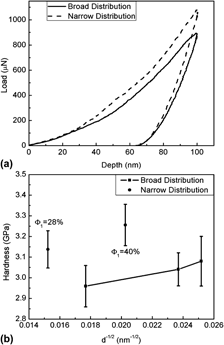Article contents
Strengthening metals by narrowing grain size distributions in nickel-titanium thin films
Published online by Cambridge University Press: 19 April 2013
Abstract

Grain size influences the mechanical strength of materials. In polycrystalline materials, strength increases with decreasing average grain size (for grains larger than 100 nm). This well-known Hall–Petch relationship typifies a strengthening mechanism, in which dislocation motion is impeded by grain boundaries. As grains become smaller, higher stresses are required to deform them. However, this formalism only considers the role of the “average” size of grains. Heterogeneous materials, however, have a broad “distribution” of grain sizes. Here we show that materials with narrowed grain size distributions have mechanical properties that differ from Hall–Petch predictions. Narrower distributions show increased strength, as their homogeneously sized grains yield at higher loads than the large grains in materials with broader grain size distributions. Plastic deformation depends on the coarsest grains, which yield first. These results suggest new routes for tailoring material properties.
- Type
- Articles
- Information
- Copyright
- Copyright © Materials Research Society 2013
References
REFERENCES
- 4
- Cited by


